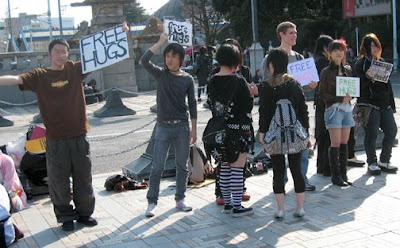
Today is Qing Ming, the day for honouring and remembering the departed members of one’s family by visiting their graves, cleaning them and offering prayers. As it is not a public holiday in Malaysia, most Chinese families observe the ritual on one of the weekends around the actual day.
Every year, we make a short trip to the cemetery where my grandparents are buried. Last Sunday was no different, as Dad and my siblings woke up early to join many families making a trip first to the market to buy roast pig and other delicious food to be offered to their ancestors, before heading to the many cemeteries around Kuala Lumpur and Petaling Jaya. We also bought vegetarian food for Grandma. It is usually a full family affair, although Mum has not made the trip these past few years ever since her mobility became somewhat restricted.
I was to have gone along too except that a severe bout of diarrhoea the night before confined me to bed. I have no problems whatsoever taking some part in these festivals, even though I observe a different faith from my family members. After all, much of the festivals and rituals that make up the Chinese way of life are not strictly religious but cultural. In fact, it is difficult to separate the elements of Confucianism, Daoism and Buddhism that make up a traditional Chinese way of life that is closely rooted to farming and the land as well as the changing of the seasons. I actually enjoy these family rituals – they remind us of the ties that are important and enduring.
When my parents were younger, we would all troop off to our grandparents’ grave on Qing Ming to find it, and all other graves, overgrown with chest-high lalang. Clearing it would be quite an effort since lalang is a particularly stubborn weed. As Mum and Dad grew older, and to spare them that onerous task, we began observing a two-step Qing Ming – Brother (and sometimes Dad) going a couple of weeks before Qing Ming to do most of the grunt work, leaving a token patch of weeds for clearing on the day itself.
I joined Brother early last month for the Step 1 big clean-up. It is relatively easy to find where our grandparents are resting – their plot is close to a frangipani tree.

When we got to the site…

… we found it in pretty good condition – no lalang, no mounds of rain-carried earth all over the concrete floors, no armies of ants making the many cracks and crevices their home! Still, we broke out the heavy equipment…

… to give the plot a good sweep. The wimpy weeds were cleared in a jiffy, and before we knew it, we were done.

Brother lit up a couple of bunches of joss sticks and placed them in front of Ah Ma and Ah Kong, before we left.

When J and I were in Kyoto a couple of weeks ago, we spent a very pleasant day strolling through the incredibly beautiful Kodaiji (temple) grounds. While tourists like us were breathing in the zen calm, the locals were visiting the adjacent cemetery and paying their respects to their loved ones. These were some of the most beautiful resting places I have encountered.

A much larger section of the cemetery is on a hill slope overlooking the city.

Family members first stop at the entrance to pick up a bucket, a scoop and some water.

Pouring water gently over the tombstones symbolises purification. The tombstones are then elegantly dressed with pretty flowers.

The plots may be tightly packed together…

… but the clean lines of individual tombstones and orderliness of the whole cemetery …

... evoked a sense of serenity and space instead of claustrophobia.


































